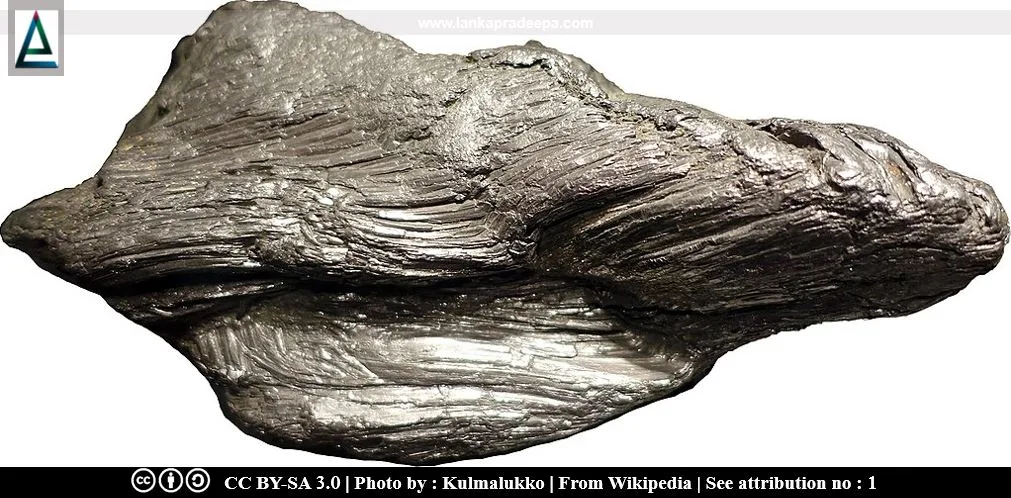
Naturally occurring graphite is typically classified into three forms, viz; i) amorphous graphite, ii) flake graphite, and iii) vein graphite (Balasooriya et al., 2007). When considering Sri Lankan Graphite, highly crystalline vein graphite is dominant (Balasooriya et al., 2007; Dissanayake, 1981).
Vein graphite deposits
The vein graphite deposits in Sri Lanka are known the world over since they were first worked in 1880 (Katz, 1987). The high purity (95-98%), crystallinity, and extensive mineralization with restricted occurrences have made these deposits more valuable and special. Most of the Sri Lankan vein graphite deposits are scattered throughout the Wanni Complex which is a Precambrian high-grade metamorphic terrain dominated by granulite-facies rocks (Katz, 1987; Touzain et al., 2010).
Sri Lanka's natural vein graphite is found in various morphologies, with different structural and physical characteristics (Balasooriya et al., 2007). They can be mainly categorized into four groups namely, i) Shiny, slippery, fibrous graphite (BSSI &KSSI), ii) Coarse flakes of radial graphite (BCFR & KCFR), iii) Coarse striated, flaky graphite (BSCF & KSCF), and iv) Platy, needle graphite [(BNPG & KNPG) Balasooriya & Bandaranayake, 2013].
Graphite production in Sri Lanka
Graphite forms one of the most important mineral exports of Sri Lanka. The availability of graphite as a mining deposit was first discovered during the Dutch Period (1658-1796 A.D.) and the mining was developed as an industry during the British Period [(1796-1948 A.D.) Abeyawardana, 2002].
By the 19th century, Sri Lanka became one of the major graphite producers in the world, especially for high quality, highly crystalline graphite, containing ca.95-98wt% of pure carbon (Touret et al., 2019). Mining had its peak during the first half of the 20th century, with over 2,500 graphite pits and mines active before World War II (Touret et al., 2019). At present, Sri Lanka is the only producer of high-quality lump and chippy dust graphite varieties, coming from a limited number of underground mines such as the Kahatagaha and Bogala mines (Touret et al., 2019).
See also
Attribution
References
1) Abeyawardana, H.A.P., 2002. Heritage of Sabaragamuwa: Major natural,
cultural and historic sites. Sabaragamuwa Development Bank and The
Central Bank of Sri Lanka. ISBN: 955-575-077-7. p.65.
2) Balasooriya, N.W.B. and Bandaranayake, P.W.S.K., 2013. Preparation of exfoliated graphite using natural graphite of Sri Lanka. J. Geological Society of Sri Lanka, 15, pp.19-29.
3) Balasooriya, N.W.B., Touzain, P. and Bandaranayake, P.W.S.K., 2007. Capacity improvement of mechanically and chemically treated Sri Lanka natural graphite as an anode material in Li-ion batteries. Ionics, 13(5), pp.305-309.
4) Dissanayake, C.B., 1981. The origin of graphite of Sri Lanka. Organic Geochemistry, 3(1-2), pp.1-7. 5) Katz, M.B., 1987. Graphite deposits of Sri Lanka: a consequence of granulite facies metamorphism. Mineralium Deposita, 22(1), pp.18-25.
6) Touret, J.L., Huizenga, J.M., Kehelpannala, K.W. and Piccoli, F., 2019. Vein-type graphite deposits in Sri Lanka: The ultimate fate of granulite fluids. Chemical geology, 508, pp.167-181.
7) Touzain, P., Balasooriya, N., Bandaranayake, K. and Descolas-Gros, C., 2010. Vein graphite from the Bogala and Kahatagaha–Kolongaha mines, Sri Lanka: a possible origin. The Canadian Mineralogist, 48(6), pp.1373-1384.
2) Balasooriya, N.W.B. and Bandaranayake, P.W.S.K., 2013. Preparation of exfoliated graphite using natural graphite of Sri Lanka. J. Geological Society of Sri Lanka, 15, pp.19-29.
3) Balasooriya, N.W.B., Touzain, P. and Bandaranayake, P.W.S.K., 2007. Capacity improvement of mechanically and chemically treated Sri Lanka natural graphite as an anode material in Li-ion batteries. Ionics, 13(5), pp.305-309.
4) Dissanayake, C.B., 1981. The origin of graphite of Sri Lanka. Organic Geochemistry, 3(1-2), pp.1-7. 5) Katz, M.B., 1987. Graphite deposits of Sri Lanka: a consequence of granulite facies metamorphism. Mineralium Deposita, 22(1), pp.18-25.
6) Touret, J.L., Huizenga, J.M., Kehelpannala, K.W. and Piccoli, F., 2019. Vein-type graphite deposits in Sri Lanka: The ultimate fate of granulite fluids. Chemical geology, 508, pp.167-181.
7) Touzain, P., Balasooriya, N., Bandaranayake, K. and Descolas-Gros, C., 2010. Vein graphite from the Bogala and Kahatagaha–Kolongaha mines, Sri Lanka: a possible origin. The Canadian Mineralogist, 48(6), pp.1373-1384.
This page was last updated on 30 April 2023

